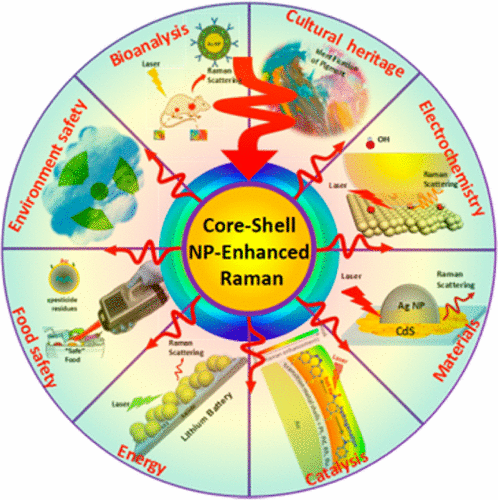当前位置:
X-MOL 学术
›
Chem. Rev.
›
论文详情
Our official English website, www.x-mol.net, welcomes your
feedback! (Note: you will need to create a separate account there.)
Core–Shell Nanoparticle-Enhanced Raman Spectroscopy
Chemical Reviews ( IF 51.4 ) Pub Date : 2017-03-08 00:00:00 , DOI: 10.1021/acs.chemrev.6b00596 Jian-Feng Li 1, 2 , Yue-Jiao Zhang 1 , Song-Yuan Ding 1 , Rajapandiyan Panneerselvam 1 , Zhong-Qun Tian 1
Chemical Reviews ( IF 51.4 ) Pub Date : 2017-03-08 00:00:00 , DOI: 10.1021/acs.chemrev.6b00596 Jian-Feng Li 1, 2 , Yue-Jiao Zhang 1 , Song-Yuan Ding 1 , Rajapandiyan Panneerselvam 1 , Zhong-Qun Tian 1
Affiliation

|
Core–shell nanoparticles are at the leading edge of the hot research topics and offer a wide range of applications in optics, biomedicine, environmental science, materials, catalysis, energy, and so forth, due to their excellent properties such as versatility, tunability, and stability. They have attracted enormous interest attributed to their dramatically tunable physicochemical features. Plasmonic core–shell nanomaterials are extensively used in surface-enhanced vibrational spectroscopies, in particular, surface-enhanced Raman spectroscopy (SERS), due to the unique localized surface plasmon resonance (LSPR) property. This review provides a comprehensive overview of core–shell nanoparticles in the context of fundamental and application aspects of SERS and discusses numerous classes of core–shell nanoparticles with their unique strategies and functions. Further, herein we also introduce the concept of shell-isolated nanoparticle-enhanced Raman spectroscopy (SHINERS) in detail because it overcomes the long-standing limitations of material and morphology generality encountered in traditional SERS. We then explain the SERS-enhancement mechanism with core–shell nanoparticles, as well as three generations of SERS hotspots for surface analysis of materials. To provide a clear view for readers, we summarize various approaches for the synthesis of core–shell nanoparticles and their applications in SERS, such as electrochemistry, bioanalysis, food safety, environmental safety, cultural heritage, materials, catalysis, and energy storage and conversion. Finally, we exemplify about the future developments in new core–shell nanomaterials with different functionalities for SERS and other surface-enhanced spectroscopies.
中文翻译:

核-壳纳米粒子增强拉曼光谱
核壳纳米粒子由于其出色的特性(例如多功能性,可调性,和稳定性。由于其惊人的可调节理化特性,它们引起了极大的兴趣。由于独特的局部表面等离振子共振(LSPR)特性,等离振子核-壳纳米材料广泛用于表面增强的振动光谱学中,尤其是表面增强的拉曼光谱学(SERS)。这篇综述在SERS的基础和应用方面对核壳纳米颗粒进行了全面概述,并讨论了许多种类的核壳纳米颗粒及其独特的策略和功能。此外,本文还详细介绍了壳分离的纳米颗粒增强拉曼光谱(SHINERS)的概念,因为它克服了传统SERS中长期存在的材料和形态通用性的局限性。然后,我们用核壳纳米粒子解释SERS增强机制,以及用于材料表面分析的三代SERS热点。为了向读者提供清晰的信息,我们总结了各种核壳纳米粒子的合成方法及其在SERS中的应用,例如电化学,生物分析,食品安全,环境安全,文化遗产,材料,催化作用以及能量存储和转化。最后,我们举例说明了具有不同功能的SERS和其他表面增强光谱学的新型核壳纳米材料的未来发展。
更新日期:2017-03-08
中文翻译:

核-壳纳米粒子增强拉曼光谱
核壳纳米粒子由于其出色的特性(例如多功能性,可调性,和稳定性。由于其惊人的可调节理化特性,它们引起了极大的兴趣。由于独特的局部表面等离振子共振(LSPR)特性,等离振子核-壳纳米材料广泛用于表面增强的振动光谱学中,尤其是表面增强的拉曼光谱学(SERS)。这篇综述在SERS的基础和应用方面对核壳纳米颗粒进行了全面概述,并讨论了许多种类的核壳纳米颗粒及其独特的策略和功能。此外,本文还详细介绍了壳分离的纳米颗粒增强拉曼光谱(SHINERS)的概念,因为它克服了传统SERS中长期存在的材料和形态通用性的局限性。然后,我们用核壳纳米粒子解释SERS增强机制,以及用于材料表面分析的三代SERS热点。为了向读者提供清晰的信息,我们总结了各种核壳纳米粒子的合成方法及其在SERS中的应用,例如电化学,生物分析,食品安全,环境安全,文化遗产,材料,催化作用以及能量存储和转化。最后,我们举例说明了具有不同功能的SERS和其他表面增强光谱学的新型核壳纳米材料的未来发展。











































 京公网安备 11010802027423号
京公网安备 11010802027423号